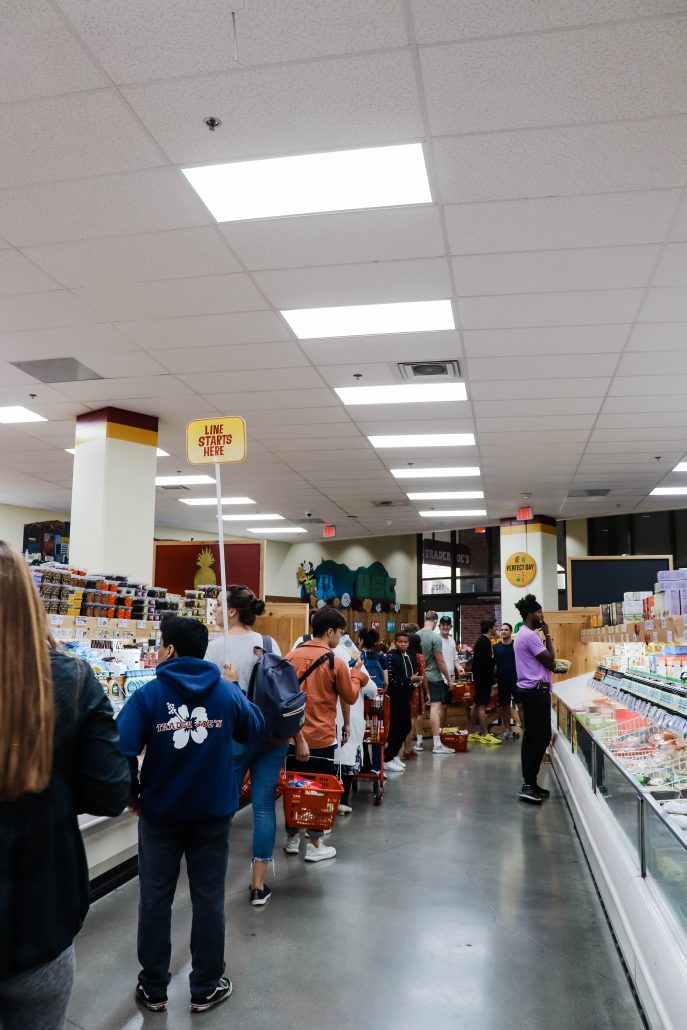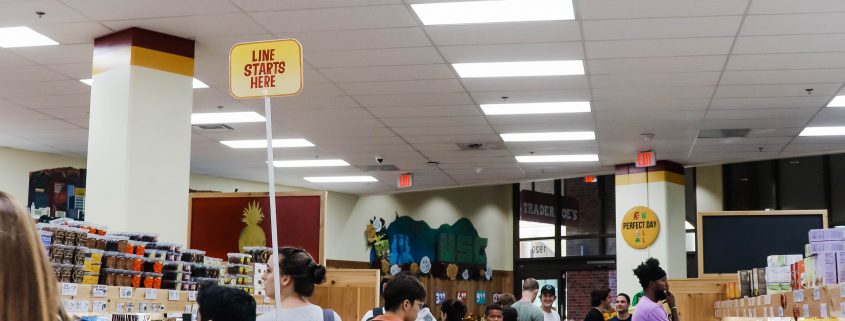Students petition to change Trader Joe’s line system

Trader Joe’s changed its checkout line system this year to have customers stand in one long queue rather than wait at individual cash registers. Students said the change has led to longer wait times. (Ally Wei | Daily Trojan)
The USC Village Trader Joe’s has changed its previously scattered queuing system into one consolidated line through the middle of the store. Since Tuesday, over 400 students have signed a petition in favor of reversing the controversial decision.
Until this semester, customers checked out by forming individual lines at each of the store’s eight cash registers.
Now, customers stand in one long queue that stretches through the freezer section and sometimes wraps around to the shelves of alcohol in the next aisle. A Hawaiian-shirt clad employee holds a sign that reads “LINE STARTS HERE,” and shoppers are ushered toward a small set of stanchions before they are pointed in the direction of a cashier.
Sophie Heukensfeldt Jansen, a senior majoring in business administration, said she started the petition during class Tuesday after weeks of frustration and conversations with friends about the new system. She learned about the mathematical process for calculating wait times — also known as queuing theory — in her Operations Management course last semester, so she understands the store’s reasoning.
“I understand that on paper, one line that splits into multiple cashiers is the fastest way to do things,” Heukensfeldt Jansen said. “In practice, it’s not working out super well. The store is very small.”
Heukensfeldt Jansen’s friend Emilie Frede, also a senior majoring in business administration, said the Trader Joe’s line had been a running joke among friends since the beginning of the semester. Frede said she called the store to complain one afternoon, and a store employee told her the longest recorded wait time was six minutes.
RJ Musulas, the store’s manager, said he had not seen the petition and declined to comment further. The Trader Joe’s company did not respond to request for comment.
Frede said that after she called, she began timing how long she stood in line at the store. After waiting for six and a half minutes Tuesday, she told Heukensfeldt Jansen, who decided to take action. Heukensfeldt Jansen posted the petition in the “USC Memes” Facebook group, which drew hundreds of student responses within hours.
“If you think about it, it does make sense to have one single queue,” Frede said. “But on the flipside … people will see a really long line and be discouraged by it.”
Frede and Heukensfeldt Jansen said they’ve both stopped frequenting the store as often, especially during peak hours. In a comment on the Facebook post that had 40 likes as of Thursday evening, Ben Brooks, a junior majoring in computer science, jokingly wrote that “the queue reduces wait times” and that “people being intimidated (and leaving) [because] of the queue’s length further reduces wait times.”
In an interview, Brooks said he was surprised to see the petition, which he hasn’t signed because he didn’t think much of the change when he first noticed it.
“I didn’t realize [the line] was annoying,” Brooks said.
The debate around the best methodology for checkout lines has been going on for at least 12 years. When Whole Foods moved to a one-line system in 2007, The New York Times reported that “consumers routinely perceive the wait to be far longer than it actually is” but that the “serpentine” system was ultimately more successful.
For New York City Trader Joe’s locations, which in 2007 had “far fewer cash registers, lines often snake around the entire perimeter of the store,” according to The Times.
In another Facebook comment, Nick Borquez, a senior majoring in astronautical engineering, called the new system “the most efficient way” to corral customers. In an interview, he said that he had read about queuing theory and decided that a single line made the most sense.
“It was entertaining to be drawn into this campus-wide debate,” Borquez said. “[It’s] something that really is not so consequential, but also it impacts a lot of people on this campus.”

